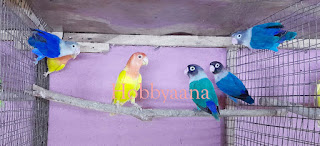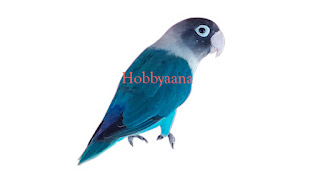Hobbyaana
Love bird complete guide Diseases and Treatment or Breeding Tips Summer and Winter Health care in English part 2
 |
| love birds |
Lovebirds are charming and colorful little parrots that have captured the hearts of bird enthusiasts around the world. These social and affectionate birds make wonderful companions, but they also require proper care to ensure they live long, healthy, and happy lives. In this comprehensive guide, we will cover essential lovebird care tips to help you provide the best environment and attention for your feathered friends.
इस लेख को हिंदी में पड़ने के लिए इसपर CLICK करेChoosing the Right Cage:
- Opt for a spacious cage with horizontal bars to provide ample room for your lovebirds to move around and exercise.
- Bar spacing should be around ½ inch to prevent escapes or injuries.
- Include perches of varying diameters to exercise their feet.
Cage Placement:
- Place the cage in a well-lit, draft-free area away from direct sunlight and extreme temperature fluctuations.
- Avoid placing the cage in the kitchen or near potential sources of fumes or toxins.
- If you read part 1 please click HERE
Nutritious Diet:
- Provide a well-balanced diet of commercial lovebird pellets, supplemented with fresh fruits, vegetables, and a small amount of seeds.
- Fresh water should always be available. Change it daily to ensure its cleanliness.
Social Interaction:
- Lovebirds are highly social birds and thrive on companionship. It's recommended to keep them in pairs or groups to prevent loneliness and depression.
- If you have a single lovebird, be prepared to spend a significant amount of time interacting with them daily.
Toys and Enrichment:
- Lovebirds are intelligent and playful creatures. Offer a variety of toys like bells, ropes, swings, and puzzle toys to keep them mentally and physically engaged.
- Rotate toys regularly to prevent boredom.
Grooming and Hygiene:
- Trim their nails if they become too long to prevent discomfort or injuries.
- Lovebirds love to bathe. Offer them a shallow dish of water or mist them lightly with a spray bottle. A regular bath helps keep their feathers clean and healthy.
Healthcare:
- Regularly observe your lovebirds for signs of illness, including changes in behavior, appetite, or appearance.
- Establish a relationship with an avian veterinarian for routine check-ups and in case of emergencies.
Safe Environment:
- Avoid using products with strong odors, fumes, or chemicals near your lovebirds, as they have sensitive respiratory systems.
- Ensure that household plants are non-toxic to birds.
Sleep Routine:
- Lovebirds need around 10 to 12 hours of sleep each night. Cover their cage partially to create a dark and quiet sleeping environment
Training and Bonding:
- Spend time taming and training your lovebirds using positive reinforcement techniques like treats and praise.
- Patience is key. Each bird has its own pace for learning and becoming comfortable with handling.
Lovebird care requires dedication and a genuine passion for these vibrant and affectionate birds. By providing a suitable environment, a nutritious diet, regular social interaction, and proper healthcare, you can ensure your lovebirds lead happy and fulfilling lives as cherished members of your household. The joy of bonding with these feathered companions will be a rewarding experience for any bird lover.
 |
| love birds |
A Comprehensive Guide to Lovebird Diseases and Treatment
Lovebirds, with their vibrant plumage and charming personalities, are popular choices as pet birds. However, like all pets, they can be susceptible to various health issues. Being informed about common lovebird diseases, their causes, symptoms, and appropriate treatments is crucial for maintaining the well-being of these beloved avian companions. In this blog, we'll delve into some of the most common lovebird diseases and offer insights into their management and treatment.
Psittacine Beak and Feather Disease (PBFD):
- Cause: PBFD is a viral disease caused by the Circovirus, primarily affecting the feathers, beak, and immune system of lovebirds.
- Symptoms: Affected birds show feather abnormalities, loss of feathers, beak deformities, weight loss, and immune system suppression.
- Treatment: There is no cure for PBFD. Supportive care includes maintaining a clean environment, proper nutrition, and minimizing stress.
Respiratory Infections:
- Cause: Bacterial, viral, or fungal infections can lead to respiratory problems in lovebirds.
- Symptoms: Sneezing, nasal discharge, labored breathing, coughing, and lethargy are common signs.
- Treatment: Treatment involves addressing the underlying cause with antibiotics, antifungal medications, and improving the bird's living conditions.
Avian Chlamydiosis (Psittacosis):
- Cause: Caused by the bacterium Chlamydia psittaci, this disease affects the respiratory system and can also be transmitted to humans.
- Symptoms: Listlessness, nasal discharge, breathing difficulties, and greenish droppings are indicative of psittacosis.
- Treatment: Treatment involves antibiotics prescribed by a veterinarian, along with good hygiene practices.
Egg Binding:
- Cause: Egg binding occurs when a female lovebird is unable to lay an egg due to various reasons, including poor nutrition, genetics, or stress.
- Symptoms: Straining, lethargy, and a distended abdomen are common signs of egg binding.
- Treatment: Gently massaging the abdomen, providing a warm and humid environment, and offering calcium supplements can help. Severe cases may require veterinary intervention.
Gastrointestinal Problems:
- Cause: Poor diet, ingestion of toxins, or bacterial infections can lead to gastrointestinal issues.
- Symptoms: Diarrhea, vomiting, decreased appetite, and lethargy are indicative of gastrointestinal problems.
- Treatment: Treatment involves addressing the underlying cause, providing a proper diet, and maintaining hygiene.
Feather Picking and Self-Mutilation:
- Cause: Psychological or physical stress can lead to lovebirds excessively picking their own feathers or engaging in self-mutilation
- Symptoms: Bald patches, broken feathers, and wounds are common signs.
- Treatment: Identifying and mitigating stressors, providing mental enrichment, and consulting a veterinarian for behavior-modifying strategies are crucial.
As a responsible lovebird owner, vigilance, preventive care, and prompt treatment are essential to ensuring the health and happiness of your feathered friends. Regular veterinary check-ups, a balanced and nutritious diet, a clean and safe environment, and attention to their behavior will go a long way in preventing and managing potential diseases. Remember, a well-informed owner is better equipped to provide the best care for their lovebirds' well-being.
 |
| love birds |
Love Birds Breeding Tips: A Comprehensive Guide
Lovebirds are cherished for their vibrant colors, playful antics, and strong pair bonds. Breeding these delightful birds can be a rewarding experience for bird enthusiasts. However, successful breeding requires careful planning, proper care, and a deep understanding of their behavior. In this comprehensive guide, we'll walk you through essential lovebird breeding tips to help you navigate this exciting journey.
1. Choosing the Right Pair: Selecting the right pair of lovebirds is crucial for successful breeding. Look for birds that are of similar age, health, and temperament. Make sure they have formed a strong bond and exhibit affectionate behavior towards each other.
2. Creating the Ideal Environment: Provide a spacious and comfortable breeding cage or aviary. A cage size of at least 24x24x24 or 18x18x36 inches is recommended for each pair of lovebirds. Place nesting boxes or suitable nesting sites within the cage, ensuring they are well-protected, dark, and cozy.
3. Nutrition and Health: Proper nutrition is essential for successful breeding. Offer a balanced diet consisting of high-quality pellets, seeds, fresh fruits, vegetables, and calcium-rich supplements. Ensure that your birds are in optimal health by scheduling regular check-ups with an avian veterinarian.
4. Pre-Breeding Conditioning: Allow your chosen pair to bond and strengthen their relationship through courtship and pre-breeding conditioning. Provide them with extra food during this time to enhance their energy levels.
5. Nesting Material: Offer a variety of nesting materials such as shredded paper, coconut fiber, and leaves. Lovebirds enjoy building their nests, and providing these materials will encourage their natural nesting instincts.
6. Monitoring and Observation: Keep a close eye on the birds during the breeding process. Observe their behavior, paying attention to any signs of aggression or distress. Be prepared to intervene if any issues arise.
7. Egg Laying and Incubation: Lovebirds typically lay eggs within a week of mating. Once eggs are laid, ensure they are not disturbed. If you notice that the female is not incubating the eggs properly, you may need to provide additional support.
8. Caring for Chicks: When the eggs hatch, the parents will care for the chicks. However, be prepared to step in if the parents are not feeding or caring for the chicks adequately. Hand-feeding may be necessary in such cases.
9. Weaning and Independence: As the chicks grow, they will gradually become independent and start to explore their surroundings. Introduce appropriate solid foods to their diet and monitor their progress.
10. Socialization: Once the chicks are fully weaned and independent, you can consider selling or finding suitable homes for them. Proper socialization during this stage will ensure that they are well-adjusted and friendly.
11. Avoiding Over-Breeding: It's important to allow your lovebirds to rest between breeding cycles. Over-breeding can be detrimental to the health of the birds. Allow them ample time to recover and regain their strength.
12. Patience and Dedication: Breeding lovebirds requires patience and dedication. Not all breeding attempts will be successful, and setbacks can occur. It's important to stay committed and learn from each experience.
Breeding lovebirds can be an incredibly rewarding endeavor for bird enthusiasts. By following these breeding tips and maintaining a deep understanding of lovebird behavior and needs, you can increase your chances of successfully raising healthy chicks. Remember that each pair of lovebirds is unique, and being attuned to their individual behaviors and needs will contribute to a successful breeding experience.
 |
| love birds |
Comprehensive Guide to Lovebird Care in Summer and Winter
Lovebirds are charming and social birds that make wonderful companions. Whether it's the scorching heat of summer or the chilly depths of winter, providing proper care for your lovebirds is essential to ensure their health and well-being. In this guide, we'll walk you through the specific care requirements for lovebirds during both summer and winter seasons.
Summer Care for Lovebirds
1. Shelter and Location:
During summer, it's crucial to protect your lovebirds from excessive heat and direct sunlight. Place their cage in a shaded area, away from drafts and direct sunlight. You can also use window shades or curtains to shield them from harsh sunlight.
2. Hydration:
The heat can cause dehydration in lovebirds, so always ensure a fresh and clean water supply. Consider using a water dispenser with a small dish to prevent spillage. Additionally, you can mist their feathers with clean, lukewarm water to help them cool down.
3. Cage Environment:
Maintain proper ventilation to prevent the cage from becoming too hot and stuffy. Place a shallow dish of water in the cage for your birds to bathe in, as they enjoy splashing around to keep cool.
4. Diet:
Adjust their diet to include cooling and hydrating foods such as fresh fruits (watermelon, cucumber, and oranges) and vegetables. You can also provide them with wet fruits or even freeze some pieces for a refreshing treat.
5. Exercise Time:
Limit outside-of-cage time during the hottest parts of the day, but provide supervised playtime during cooler hours. This ensures they don't overexert themselves in the heat.
6. Grooming:
Trim their feathers if they have long ones to prevent overheating. However, avoid excessive trimming as they still need some feathers for insulation.
Winter Care for Lovebirds
1. Warmth and Location:
Cold temperatures can be challenging for lovebirds. Place their cage away from drafts and cold windows. Provide extra insulation around their cage, such as blankets or towels, to keep them warm.
2. Heating:
If the temperature drops significantly, consider using a small bird-safe heater in the room where they are kept. Make sure it is placed at a safe distance from the cage to prevent any accidents.
3. Cage Environment:
To counteract the dry indoor air, you can use a humidifier to maintain a comfortable humidity level. Also, provide them with cozy bedding materials like shredded paper or cloth to snuggle into.
4. Diet:
During winter, lovebirds require additional energy to stay warm. Offer them a varied diet that includes more complex carbohydrates and healthy fats. Seeds, grains, and nuts can be included in their diet.
5. Activity and Mental Stimulation:
Since outdoor playtime might be limited, provide plenty of toys and mental stimulation within their cage to prevent boredom and keep them active.
6. Monitoring:
Keep a close eye on their health during the colder months. If you notice any signs of illness, consult an avian veterinarian immediately.
General Tips for Year-round Care
Regular Vet Visits: Regardless of the season, schedule regular check-ups with an avian veterinarian to ensure your lovebirds' health.
Social Interaction: Lovebirds thrive on social interaction. Spend quality time with them, talking to them and engaging in gentle interactions.
Clean Environment: Maintain a clean and hygienic cage, changing their bedding regularly and cleaning their food and water dishes daily.
Safe Environment: Remove hazards from their environment, such as toxic plants, open windows, and other potential dangers.
Observation: Pay attention to your lovebirds' behavior. Any sudden changes could be indicative of an underlying health issue.
By following these guidelines, you can provide your lovebirds with the care they need to thrive in both summer and winter. Remember, your attentiveness and dedication contribute to the happiness and well-being of these delightful avian companions.
 |
| love birds |
Lovebirds Care: The Do's and Don'ts for Happy and Healthy Companions
Lovebirds, with their vibrant colors and affectionate behavior, have captured the hearts of bird enthusiasts worldwide. As delightful and charming as they are, these small parrots require specific care to thrive in captivity. Whether you're a new lovebird owner or seeking to enhance your knowledge, this comprehensive guide will outline the essential do's and don'ts of lovebird care.
Do's:
Provide a Spacious Cage: Lovebirds are active and playful creatures that require ample space to exercise and explore. A cage that's at least 36 inches wide, 18 inches deep, and 18 inches high is recommended for a single pair of lovebirds.
Pair Them Up: Lovebirds are social birds that thrive in pairs or small groups. They form strong bonds with their mates, exhibiting affectionate behaviors like preening each other and sharing food. If you can't spend enough time with your lovebird, consider keeping them in pairs to prevent loneliness.
Nutritious Diet: A balanced diet is crucial for the well-being of your lovebirds. Provide a high-quality pellet mix supplemented with fresh fruits, vegetables, and sprouted seeds. Avoid avocados, chocolate, caffeine, and alcohol, as these are toxic to birds.
Fresh Water Daily: Make sure to offer clean, fresh water to your lovebirds every day. Water dishes should be washed and refilled regularly to prevent the growth of bacteria.
Environmental Enrichment: Lovebirds are intelligent and curious birds that need mental stimulation. Offer a variety of toys, perches, and climbing structures to keep them entertained. Rotating toys every few weeks can prevent boredom.
Regular Vet Visits: Schedule regular visits to an avian veterinarian to ensure your lovebirds' health. Annual check-ups can catch any potential health issues early on.
Gentle Handling: Establish trust with your lovebirds through gentle and patient handling. Gradually build their confidence by offering treats and allowing them to step onto your hand. Avoid sudden movements or grabbing, as this can cause stress.
Provide Nesting Options: If you plan on breeding lovebirds, offer a nesting box in the cage. Make sure it's appropriately sized and positioned, and provide nesting materials like coconut fibers or shredded paper.
Don'ts:
Isolate Them: Lovebirds are social creatures that can become lonely and depressed if kept in isolation. Avoid keeping a single lovebird without any companionship.
Expose to Drafts: Lovebirds are sensitive to temperature changes. Place their cage away from drafty windows, air conditioning vents, or direct sunlight, as extreme temperatures can be harmful.
Forceful Interactions: Never force your lovebirds to do something they're uncomfortable with. Forcing them onto your hand or into a new environment can damage their trust and cause stress.
Unattended Out-of-Cage Time: While it's important to provide out-of-cage time for exercise and exploration, never leave your lovebirds unattended outside their cage. They can get into hazardous situations or chew on items that are harmful to them.
Overcrowding: While lovebirds are social, avoid overcrowding their cage with too many birds. This can lead to territorial conflicts and stress.
Toxic Plants and Substances: Lovebirds love to chew on things, and they might ingest toxic substances or plants. Keep them away from any potentially harmful items.
Neglecting Cleaning: Regularly clean the cage, perches, toys, and food dishes to maintain a hygienic environment. Accumulated droppings and food debris can lead to health problems.
Unsupervised Introductions: When introducing new lovebirds to an existing pair, do so under close supervision. Aggressive behavior can occur, and it's important to monitor their interactions to prevent injury.
By following these do's and don'ts of lovebird care, you'll create a safe, stimulating, and loving environment for your feathered companions. Remember, lovebirds can live for 10 to 15 years or even longer with proper care, so your commitment to their well-being will lead to years of joy and companionship.
 |
| love birds |
If you read another article please click this - Tuberose Adenium Bougainvillea Budgie parrot Chrysanthemum




No comments:
Post a Comment